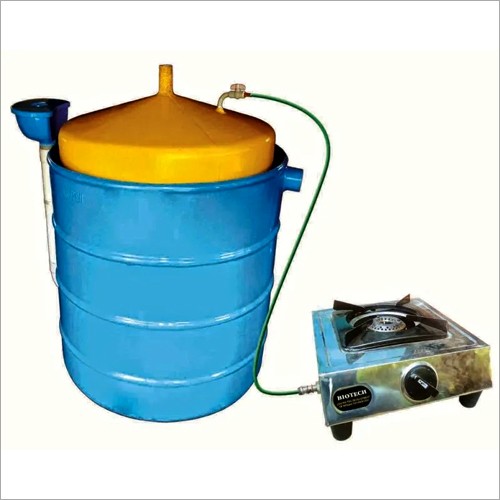
Domestic biogas plant have emerged as a promising and sustainable technology that not only addresses the growing energy needs of households but also contributes to efficient waste management and environmental conservation. These small-scale biogas systems are designed to convert organic waste materials, such as kitchen scraps and livestock dung, into biogas, a clean and renewable source of energy. In this article, we will explore the benefits, working principles, and potential impact of domestic biogas plants on households and the environment.
The Basics of Domestic Biogas Plants
Domestic biogas plant, also known as household biogas digesters, are compact anaerobic digestion systems that provide a decentralized and eco-friendly solution for energy production. They are typically installed on the premises of individual households, farms, or small-scale agricultural operations. The key components of a domestic biogas plants include:
Biogas Digester: The heart of the system is the biogas digester, which is usually an underground or semi-underground tank. It is designed to receive organic waste inputs, such as food scraps, animal manure, and agricultural residues.
Microorganisms: Anaerobic microorganisms, particularly methanogenic bacteria, play a crucial role in the biogas production process. These microbes break down the organic matter in the digester in the absence of oxygen, converting it into biogas.
Biogas Holder: A gas holder or gas storage unit is connected to the digester to collect and store the biogas produced. This prevents pressure buildup in the digester and allows for controlled release of biogas for household use.
Biogas Outlet: The biogas is piped from the gas holder to the point of use, typically the kitchen or a dedicated gas stove.
Effluent Outlet: The residue left after the digestion process, known as digestate or effluent, can be used as nutrient-rich fertilizer for crops.
Working Principles of Domestic Biogas Plants
The operation of domestic biogas plant follows a relatively simple set of principles:
Feedstock Preparation: Organic waste materials, such as kitchen scraps, animal dung, and agricultural residues, are collected and mixed in a slurry. This mixture is fed into the biogas digester.
Anaerobic Digestion: Inside the digester, anaerobic microorganisms break down the organic matter in the absence of oxygen. This microbial activity produces biogas, which is composed mainly of methane (CH4) and carbon dioxide (CO2).
Biogas Collection: As biogas is produced, it displaces the air inside the gas holder, causing it to rise. The gas holder moves upward, and the biogas is collected.
Gas Utilization: The collected biogas can be piped to the household kitchen or a gas stove for cooking and heating purposes. Biogas can also be used for lighting or electricity generation, depending on the system’s design.
Digestate Management: The remaining digestate or effluent is rich in nutrients and can be used as an organic fertilizer for crops, thus closing the loop in waste management.
Benefits of Domestic Biogas Plants
Clean Energy Production: Domestic biogas plant provide a renewable source of clean energy that can replace traditional sources like firewood or fossil fuels for cooking and heating, reducing indoor air pollution and greenhouse gas emissions.
Waste Reduction: These systems effectively convert organic waste into valuable biogas and nutrient-rich fertilizer, reducing the amount of waste that needs to be disposed of in landfills or open dumping sites.
Improved Health: By replacing traditional cooking methods with biogas, households can reduce exposure to harmful indoor air pollutants, resulting in improved respiratory health, particularly for women and children.
Economic Benefits: Biogas can reduce household energy costs, as it is often cheaper than purchasing liquefied petroleum gas (LPG) or other conventional fuels. Additionally, the digestate can enhance crop yields, leading to increased agricultural productivity.
Environmental Conservation: The use of biogas reduces the reliance on non-renewable energy sources and minimizes greenhouse gas emissions, contributing to environmental conservation and climate change mitigation.
Challenges and Considerations
While domestic biogas plants offer numerous advantages, there are some challenges and considerations to keep in mind:
Initial Investment: The upfront cost of installing a biogas plant can be a barrier for some households, particularly in low-income areas. However, government subsidies and financial incentives may help offset these costs.
Maintenance: Proper maintenance is crucial to ensure the efficient operation of biogas plants. This includes regular cleaning, monitoring, and occasional repairs.
Feedstock Availability: The consistent availability of organic waste materials is essential for continuous biogas production. Households must actively collect and prepare feedstock.
Technical Knowledge: Users may need training and technical knowledge to operate and maintain the biogas system effectively.
Conclusion
Domestic biogas plants represent a sustainable and eco-friendly solution for households and communities looking to address both their energy needs and waste management challenges. By converting organic waste into clean and renewable biogas, these systems not only provide a source of clean energy but also contribute to waste reduction, improved health, and environmental conservation. As the world seeks ways to transition to more sustainable and resilient energy systems, domestic biogas plants offer a practical and scalable option for individuals and communities to embrace a greener and more sustainable future.
